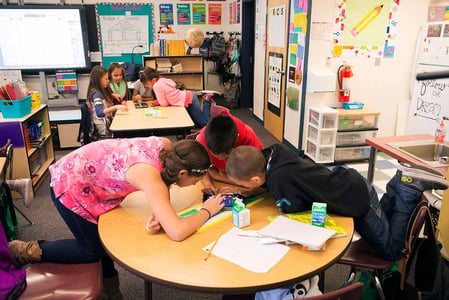
Student engagement is crucial for learning. Students who understand the rules and routines of the classroom and have something to do are less likely to engage in disruptive behavior, allowing the teacher to focus more on instruction. Engagement is only heightened when teachers make learning come alive. Warm, caring, and responsive teachers inspire students to focus on classroom activities, whether a read-aloud in an early childhood classroom or a writing activity in an upper-grade classroom.
Research demonstrates a strong association between high levels of Classroom Organization and student engagement. Students in highly organized classrooms exhibit less time off task and more time focused on learning. If you think about the purpose of this domain (what teachers do to manage students’ time, attention, and behavior in the classroom), this makes sense. High levels of Classroom Organization are also associated with executive functioning skills, which help students better attend to the task at hand.
Classroom Organization is not the only dimension that affects student engagement. Emotional Support is also associated with student engagement and buffers the typical negative association between problem behavior and approaches to learning. That is, when Emotional Support is high, we see a decrease in problem behaviors, leading to higher levels of engagement.
Rimm-Kaufman, Barody, Larsen, Curby, and Abry (2015) examined the relationship between CLASS scores and student engagement during mathematics instruction in sixty-three 5th-grade classrooms. They used three methods to study engagement: 1) a time-sampling observational system that indicated whether students were engaged or disengaged, 2) a teacher report of engagement, and 3) a student report on engagement. In addition, they measured four types of engagement: cognitive, emotional, behavioral, and social engagement.
Results of the study showed that students in classrooms with higher levels of Emotional Support reported greater cognitive, emotional, and social engagement, whereas students in classrooms with higher Classroom Organization reported greater levels of cognitive, emotional, and social engagement. Girls in classrooms with higher levels of Instructional Support reported higher social engagement, but this was not the case for the boys.
This research is exciting because it helps us understand in very tangible ways steps that teachers can take to increase student engagement. And students who are not engaged aren’t learning.
Citation:
Rimm-Kaufman, S. E., Baroody, A., Larsen, R., Curby, T. W., & Abry, T. (2015). To what extent do teacher-student interaction quality and student gender contribute to fifth graders' engagement in mathematics instruction? Journal of Educational Psychology, 107, 170-185.
